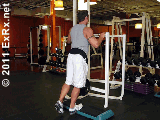Step 1
Starting Position: Place a BOSU® balance trainer, blue dome side up, on a non-slip surface on the floor, 3-6" to your left. Stand with your feet hip-width apart or closer; arms by your sides. Pull your shoulders blades down and back toward your hips. "Brace" (engage your abdominal / core muscles) to stabilize your spine.
Step 2
Downward Phase: Shift your hips back and down. This will create a hinge-like movement at your knees. Continue to lower yourself until you feel your heels about to lift off the floor. Try to maintain a flat back by bending forward at the hips. Keep your head facing directly forward and position your arms where they offer the greatest degree of balance support.
Step 3
Jumping Movement: With ONLY a slight pause at the bottom of your downward phase, explode up and to the left, landing on top of the BOSU. Try to fully extend the hips, knees and ankles as you explode on to the BOSU. As you jump into the air, try to keep your feet level with each other and parallel with the floor, but bring them together to land on the top of the BOSU.
Step 4
Landing: The most important components of the landing phase on a BOSU are correct foot position and avoiding excessive forward movement in your legs, which will cause additional stress on your knees.
Step 5
Try to land softly and quietly on the mid-foot, quickly rolling toward the heels in order to level the foot, making it parallel with the floor. Always push your hips backwards and drop your hips to absorb the jumping forces. Do not lock your knees on the landing in order to avoid potential knee injuries.
Step 6
Land with your trunk slightly forward, head aligned with your spine and back rigid or flat. Keep your abdominal / core muscles engaged; your torso rigid to protect your spine.
Step 7
With ONLY a slight pause at the bottom of your landing phase, explode up and to the left, off the top of the BOSUtoward the floor. Try to fully extend the hips, knees and ankles as you explode off of the BOSU. As you jump into the air, try to keep your feet level with each other and parallel with the floor, moving them back to a hip-width distance or slightly closer.
Step 8
Repeat the movement jumping to the right.
Exercise Variation: As you develop your jumping and landing skills, you can progress the exercise intensity and complexity by: (1) driving your arms behind you during the downward phase, (2) driving your arms forward, upward (towards an overhead position) and slightly sideways in the jumping direction during the jumping phases, (3)driving your knees towards your chest during the jumping phases or (4) moving back and forth more rapidly or adding more BOSU balance trainers and performing a series of jumps in each direction.
Before attempting to jump laterally onto the BOSU, learn first how to squat and perform regular squat jumps, BOSU squat jumps and lateral cone jumps.
For professional guidance in your exercise program,
find an ACE-certified Personal Trainer in your area. Before beginning any fitness program, always see a qualified healthcare provider for advice and to address any questions or concerns. The exercises presented on this website are for suggestion only and should not be substituted for medical diagnosis or treatment. Participate at your own risk and stop if you feel faint or experience shortness of breath.
Source























